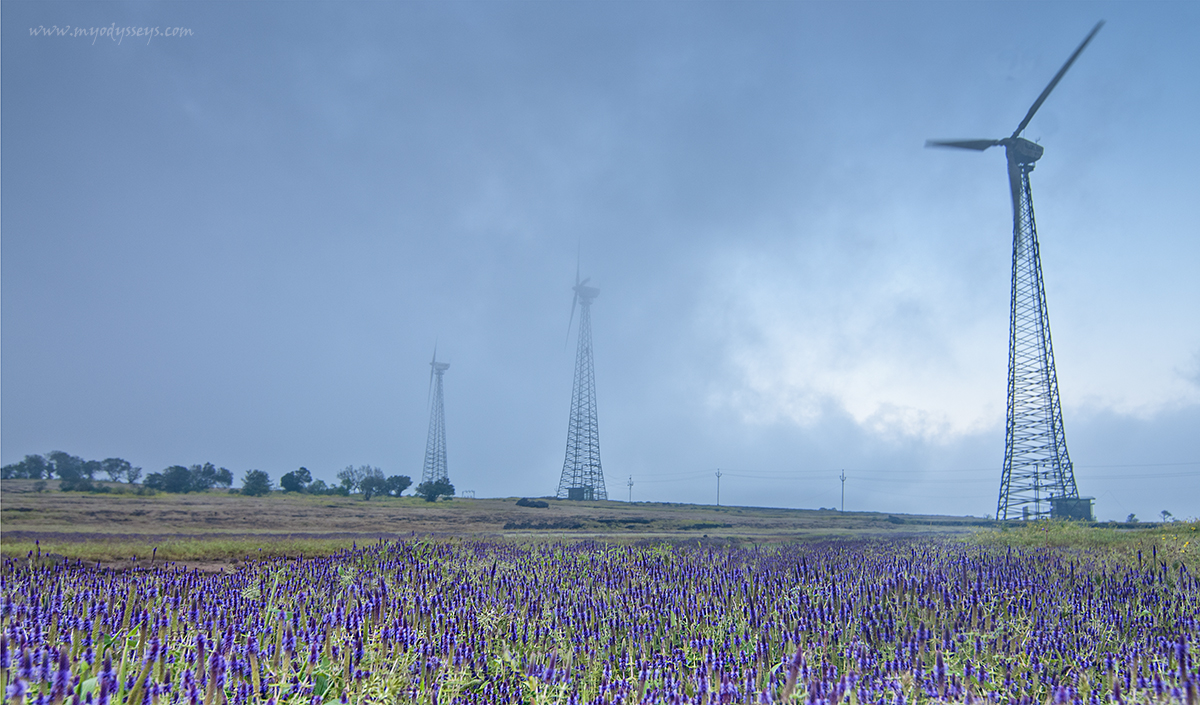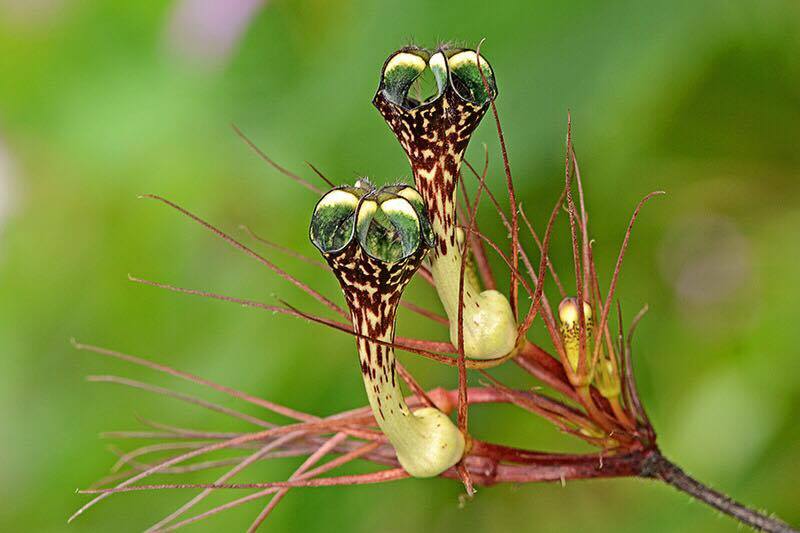The Rare Flowers of Sahyadri
The scent of the wild,
the play of the breeze,
and thousand heads tossing,
with the untamed wind.
The dew drops like,
diamond glisten
on blue, magenta
purple and green
I take this path,
less taken
For the gems that lay
on my path strewn..
A carpet of Jambhli Manjiri at Satara (Image by - Jyoti Rane)
In
my last 15 years of trekking experience all that groped my attention
was these tiny, miniscule, vivid and rare nodding beauties, the rare wild
flowers. The rare flowers of Sahyadris, I was obsessed to write a book on them
featuring their photographs, but had to shed the project because of lack of
research. The fascination is still on and hopes can still be explored. Yet, in
this short account of rare wild flowers of Sahyadris, I wish to bring the rare,
unexplored wild flowers which being in your vicinity are sometimes so conspicuous.
It’s a game of find and seek. I have here one
of the Macro Experts and Photographer from India - Mr. Yuwaraj Gurjar sharing his pictures with me, in this blog, to bring the best experience forth.
A commanding hill slope at Torna Fort painted with Balsam (Pink) & Sonki (Yellow) bloom
(Image by - Jyoti Rane)
Trekking
is not much of a sport to the Indian community, but the ones who trek have and
will explore the glory of these wild flowers. Sahyadris holds a habitat
conducive for over 2000 species of wild blooms. The spread is across seasons
and different season have their varied charm. While monsoons and post monsoons
enjoys the best and maximum spread of wildflowers, the winters offer equally colorful
flowers. Different flowers grow over varying altitude and the species change
with every changing month. The monsoons remain the best time to explore.
The
description on the rare flowers of Sahyadris here has been kept very
non-scientific and non-technical for the understanding of the maximum readers. The approach is to highlight the local flower names for the benefit of ease in remembering.
The Rare Sahyadri flowers (Image by Yuwaraj Gurjar)
Research
shows there are more than 150 species which are endemic to the North Western
Ghats (Sahyadris), which means exclusively found here. Amongst the rare flowers
of Sahyadris, there are some species which bloom once in 7 years. There are
species which blanket the hill slopes
and floor from August onwards. While some are insectivorous and others cleverly
camouflaged to the naked eye. While the taxonomist and biologist are working
their best to identify and document, various species are still under scanner
and study. 2000 plus flower species adorn the Sahyadris and present a colorful palette
which only remains a sight to behold.
Abhali (Image by Yuwaraj Gurjar)
Seetechi Aswe (Image by Yuwaraj Gurjar)
Flower Expert Mr. Shrikant Ingalhalikar has penned a
series of 3 books on Flowers of Sahyadris. His extensive research in this field
draws some spectacular observations like different flowers bloom over months,
weeks and sometimes just minutes. Flowers that bloom at noon, mid night and
through the day. His books on Flowers of Sahyadris are the best field guides for
exploring the rare gems of wild flowers in Sahyadris.
While
we begin our journey of bringing you the rare flowers of Sahyadris, stay put
and wonder behind the effort at spotting the flowers, identifying them and
photographing them (sometimes under difficult situations).
The cordoned kas meadows (Image by - Jyoti Rane)
What
remains much known to the major trekking fraternity and otherwise are the
flowers like Karvi (Strobilanthes Callosus), which blooms once in 7 years. The hills are painted purple with the rare bloom.
A rare Karvi bloom once in 7 years (Image by Yuwaraj Gurjar)
Karvi comes in various formations and named as Topli Karvi, Bhui Karvi etc.
Karvi (Image by Amit Rane)
Sonki (Senecio bombayensis)the yellow wild head that blankets the hills from early September.
Sonki bloom at Torna fort (Image by - Jyoti Rane)
Balsam (Impatiens balsamina) the ubiquitous flower of the Sahyadris.
What needs to be seen is much beyond this and what holds to be visualised is a
highly colourful and captivating world of wild flowers.
Balsam flowers at Kas (Image by Amit Rane)
Ceropegias (Local Name - Kharchudi)
This flower come in unusual shapes and formations. The Ceropagia species is the
rare kinds and difficult to spot. It is highly colourful and comes in the most
distinct formations. Ceropagias have unusual pitcher shaped formation for influencing
pollination. The shape renders insects to be trapped for a while before they
move out.
Medi Kharchudi - Ceropagia Media (Image by Yuwaraj Gurjar)
Ceropegia (Image by Yuwaraj Gurjar)
Mor Kharchudi (Image by Yuwaraj Gurjar)
Ceropegia (Image by Yuwaraj Gurjar)
Ceropegia Vincaefolia (Image by Yuwaraj Gurjar)
Ceropegia (Image by Yuwaraj Gurjar)
An outstanding perspective of Ceropegia Hirsuta ( Image by Yuwaraj Gurjar)
An outstanding perspective of Ceropegia Hirsuta ( Image by Yuwaraj Gurjar)
Different species of Ceropegia (Image by Yuwaraj Gurjar)
The
Drossera indica and Drossera burmani are insectivorous flowers and are so
minute as small as 1 centimeter that one needs to be actually patient to spot them.
Dav bindu - Drossera burmani (Image by - Amit Rane)
Drossera indica (Image by - Amit Rane)
The
snake flower, also known as cobra lily is a perfect imitation of a snake
flicking its tongue.
Murray's Cobra Lily - Pandhra Sap Kanda ( Source - Flowers of India)
Whipcord Cobra Lily (Source - Wikipedia)
The
Orchidaceae family presents a variety of species in formations like a doll, a
comb and many others. Commonly known as
Habe Amri, the flowers appear in yellow and white colors.
Chire Habe Amri (Image by Yuwaraj Gurjar)
Bahuli Habe Amri (Image by Yuwaraj Gurjar)
Pan Kusum - Forest Spider Lily (Image by Yuwaraj Gurjar)
Waghchora (Image by Yuwaraj Gurjar)
Approach & Challenges
- The approach is not easy. Spotting and photographing these flowers in the wild is a challenge. Challenge because one needs to have a very keen eye to spot these flowers. The wind in the outdoors in uncontrollable, photographing under such situations is difficult.
- Some flower species are rare and found at certain high altitude only.
- Some flower species are very tiny (as small as 1 cm)
- Some are available only across the slopes and therefore have difficult access.
- Most of the Sahyadri flowers bloom in monsoons, spotting them and photographing them along knee length grass is an open invitation to reptiles too.
Kusum (Image by Yuwaraj Gurjar)
Deepkadi ( Image by Amit Rane)
Do's & Dont's
- Don't risk at places to obtain a flower species, as there will be certainly another sample to find.
- Don't pluck these wild flowers or tread on them, as they already have a very small life.
- Sit and enjoy the flowers, its a treat to the eyes.
- Carry field guides on Sahyadri Flowers for your treks and trips to identify better.
- Look for specifications, a flower family is further classified under different species with minute demarcations.
- Observe the formations and don't forget to smell them.
- Experience different flowers across different seasons.
- Fall in love with them as they are worth your affinity.
- Look out for reptiles when you venture for spotting wild flowers.
Udi Chirayat (Image by Yuwaraj Gurjar)
Kurdu Flower (Image by Yuwaraj Gurjar)
Links - For flowers of Kas -
https://myodysseyss.wordpress.com/2010/10/28/kas-chronicles/


























































